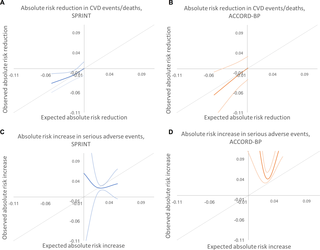PLOS Medicine ( IF 15.8 ) Pub Date : 2017-10-17 , DOI: 10.1371/journal.pmed.1002410 Sanjay Basu 1, 2, 3, 4 , Jeremy B Sussman 5, 6 , Joseph Rigdon 7 , Lauren Steimle 8 , Brian T Denton 8 , Rodney A Hayward 5, 6

|
Background
Intensive blood pressure (BP) treatment can avert cardiovascular disease (CVD) events but can cause some serious adverse events. We sought to develop and validate risk models for predicting absolute risk difference (increased risk or decreased risk) for CVD events and serious adverse events from intensive BP therapy. A secondary aim was to test if the statistical method of elastic net regularization would improve the estimation of risk models for predicting absolute risk difference, as compared to a traditional backwards variable selection approach.
Methods and findings
Cox models were derived from SPRINT trial data and validated on ACCORD-BP trial data to estimate risk of CVD events and serious adverse events; the models included terms for intensive BP treatment and heterogeneous response to intensive treatment. The Cox models were then used to estimate the absolute reduction in probability of CVD events (benefit) and absolute increase in probability of serious adverse events (harm) for each individual from intensive treatment. We compared the method of elastic net regularization, which uses repeated internal cross-validation to select variables and estimate coefficients in the presence of collinearity, to a traditional backwards variable selection approach. Data from 9,069 SPRINT participants with complete data on covariates were utilized for model development, and data from 4,498 ACCORD-BP participants with complete data were utilized for model validation. Participants were exposed to intensive (goal systolic pressure < 120 mm Hg) versus standard (<140 mm Hg) treatment. Two composite primary outcome measures were evaluated: (i) CVD events/deaths (myocardial infarction, acute coronary syndrome, stroke, congestive heart failure, or CVD death), and (ii) serious adverse events (hypotension, syncope, electrolyte abnormalities, bradycardia, or acute kidney injury/failure). The model for CVD chosen through elastic net regularization included interaction terms suggesting that older age, black race, higher diastolic BP, and higher lipids were associated with greater CVD risk reduction benefits from intensive treatment, while current smoking was associated with fewer benefits. The model for serious adverse events chosen through elastic net regularization suggested that male sex, current smoking, statin use, elevated creatinine, and higher lipids were associated with greater risk of serious adverse events from intensive treatment. SPRINT participants in the highest predicted benefit subgroup had a number needed to treat (NNT) of 24 to prevent 1 CVD event/death over 5 years (absolute risk reduction [ARR] = 0.042, 95% CI: 0.018, 0.066; P = 0.001), those in the middle predicted benefit subgroup had a NNT of 76 (ARR = 0.013, 95% CI: −0.0001, 0.026; P = 0.053), and those in the lowest subgroup had no significant risk reduction (ARR = 0.006, 95% CI: −0.007, 0.018; P = 0.71). Those in the highest predicted harm subgroup had a number needed to harm (NNH) of 27 to induce 1 serious adverse event (absolute risk increase [ARI] = 0.038, 95% CI: 0.014, 0.061; P = 0.002), those in the middle predicted harm subgroup had a NNH of 41 (ARI = 0.025, 95% CI: 0.012, 0.038; P < 0.001), and those in the lowest subgroup had no significant risk increase (ARI = −0.007, 95% CI: −0.043, 0.030; P = 0.72). In ACCORD-BP, participants in the highest subgroup of predicted benefit had significant absolute CVD risk reduction, but the overall ACCORD-BP participant sample was skewed towards participants with less predicted benefit and more predicted risk than in SPRINT. The models chosen through traditional backwards selection had similar ability to identify absolute risk difference for CVD as the elastic net models, but poorer ability to correctly identify absolute risk difference for serious adverse events. A key limitation of the analysis is the limited sample size of the ACCORD-BP trial, which expanded confidence intervals for ARI among persons with type 2 diabetes. Additionally, it is not possible to mechanistically explain the physiological relationships explaining the heterogeneous treatment effects captured by the models, since the study was an observational secondary data analysis.
Conclusions
We found that predictive models could help identify subgroups of participants in both SPRINT and ACCORD-BP who had lower versus higher ARRs in CVD events/deaths with intensive BP treatment, and participants who had lower versus higher ARIs in serious adverse events.
中文翻译:

强化血压治疗的利弊:使用 SPRINT 和 ACCORD 试验数据推导和验证风险模型
背景
强化血压 (BP) 治疗可以避免心血管疾病 (CVD) 事件,但会导致一些严重的不良事件。我们试图开发和验证风险模型,用于预测 CVD 事件和强化 BP 治疗引起的严重不良事件的绝对风险差异(风险增加或风险降低)。第二个目的是测试与传统的向后变量选择方法相比,弹性净正则化的统计方法是否会改进用于预测绝对风险差异的风险模型的估计。
方法和发现
Cox 模型源自 SPRINT 试验数据,并在 ACCORD-BP 试验数据上进行验证,以估计 CVD 事件和严重不良事件的风险;这些模型包括强化 BP 治疗和对强化治疗的异质反应的术语。然后使用 Cox 模型来估计强化治疗中每个人 CVD 事件概率的绝对减少(益处)和严重不良事件(伤害)概率的绝对增加。我们将弹性网络正则化方法与传统的向后变量选择方法进行了比较,该方法使用重复的内部交叉验证来选择变量并在存在共线性的情况下估计系数。来自 9,069 名具有完整协变量数据的 SPRINT 参与者的数据被用于模型开发,来自 4、498 名具有完整数据的 ACCORD-BP 参与者被用于模型验证。参与者接受强化(目标收缩压 < 120 毫米汞柱)与标准(<140 毫米汞柱)治疗。评估了两个复合主要结局指标:(i) CVD 事件/死亡(心肌梗塞、急性冠状动脉综合征、中风、充血性心力衰竭或 CVD 死亡),和 (ii) 严重不良事件(低血压、晕厥、电解质异常、心动过缓,或急性肾损伤/衰竭)。通过弹性净正则化选择的 CVD 模型包括交互项,表明年龄较大、黑人种族、较高的舒张压和较高的血脂与强化治疗带来的更大的 CVD 风险降低益处相关,而目前吸烟与较少的益处相关。通过弹性净正则化选择的严重不良事件模型表明,男性、目前吸烟、使用他汀类药物、肌酐升高和血脂升高与强化治疗发生严重不良事件的风险更大有关。最高预期获益亚组中的 SPRINT 参与者需要治疗的数量 (NNT) 为 24,以在 5 年内预防 1 次 CVD 事件/死亡(绝对风险降低 [ARR] = 0.042,95% CI:0.018、0.066;P = 0.001),中间预测受益亚组的 NNT 为 76(ARR = 0.013,95% CI:-0.0001, 0.026;P = 0.053),最低亚组的风险没有显着降低(ARR = 0.006, 95% CI: -0.007, 0.018; P = 0.71)。最高预测伤害亚组中的那些需要伤害 (NNH) 为 27 次以诱发 1 起严重不良事件(绝对风险增加 [ARI] = 0.038,95% CI:0.014、0.061;P = 0.002),中等预测危害亚组的 NNH 为 41(ARI = 0.025,95% CI:0.012,0.038 ;P < 0.001),最低亚组的风险无显着增加(ARI = -0.007,95% CI:-0.043 , 0.030; P= 0.72)。在 ACCORD-BP 中,预测收益最高亚组的参与者具有显着的绝对 CVD 风险降低,但与 SPRINT 相比,整个 ACCORD-BP 参与者样本偏向于预测收益较少而预测风险较高的参与者。通过传统的反向选择选择的模型与弹性网模型具有相似的识别 CVD 绝对风险差异的能力,但正确识别严重不良事件的绝对风险差异的能力较差。该分析的一个关键限制是 ACCORD-BP 试验的样本量有限,该试验扩大了 2 型糖尿病患者 ARI 的置信区间。此外,不可能机械地解释解释模型捕获的异质治疗效果的生理关系,
结论
我们发现预测模型可以帮助识别 SPRINT 和 ACCORD-BP 的参与者亚组,在强化血压治疗的 CVD 事件/死亡中,ARRs 较低与较高,以及严重不良事件中 ARIs 较低与较高的参与者。


























 京公网安备 11010802027423号
京公网安备 11010802027423号